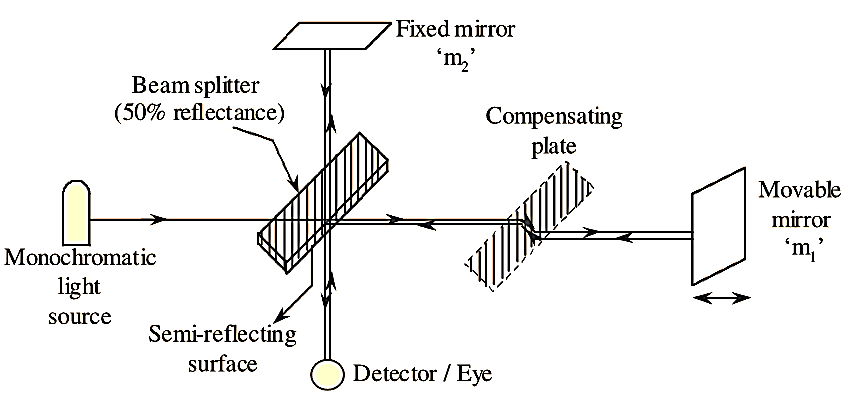
Figure 1: Michelson Interferometer.
Michelson interferometer or DC laser interferometer is the oldest device. It utilizes monochromatic light from an extended source, and works on the principle of interference.
Working & Construction of Michelson interferometer
In Michelson interferometer, a beam splitter and two mirrors are used, in which one mirror is fixed and the other is movable (see Figure 1). When a light ray from the source falls on the beam splitter, it gets separated into two rays at 90°. One ray is projected towards the mirror m1 and other is reflected towards the mirror m2. From both mirrors, rays are reflected back and the ray from m1 is considered as reference beam. These reflected rays combine together at semi-reflecting surface and move towards the detector. If the mirrors are at equal distance from beam splitter, light appears in phase and a bright spot can be seen, because of constructive interference. If mirror m1 is shifted by $\frac{1}{4}\text{ th}$ wavelength, light beam is observed 180° out of phase and dark spot is seen, because of destructive interference.
Every half wavelength shift of mirror results in change in calculated optical path of one wavelength, and the beam from m1 shifts through 360°. The reference beam from m2 and the reflected ray from m1 combine at beam splitter, counter acting. Therefore, for each cycle of intensity at the detector, $\frac{\lambda }{2}$ of mirror shift takes place.
For a white light source, the formation of fringes takes place if both the ray paths must be same as few wavelengths in total length in glass and air. The fringe formation is influenced due to difference of lengths. Thus a compensating plate is used in between beam splitter and mirror m1 to obtain equal amounts of glass for the ray paths.